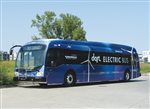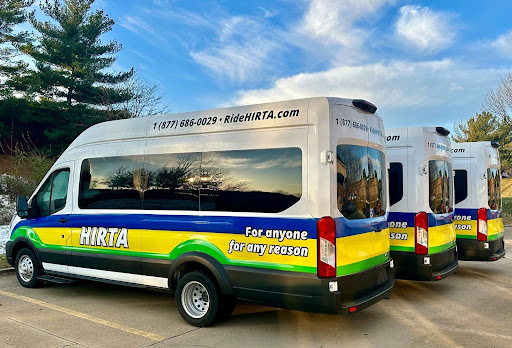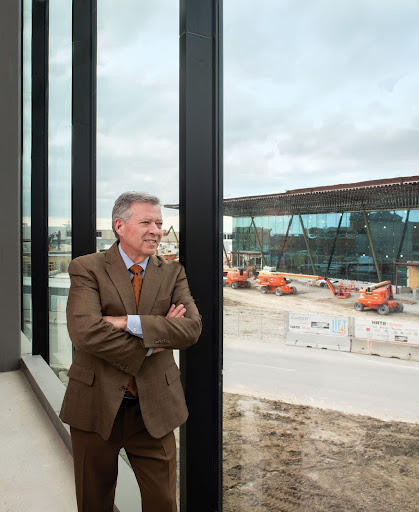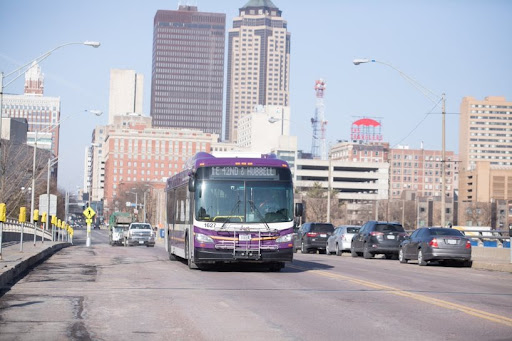DART launches electric bus pilot program as it explores transition to clean energy transportation

MICHAEL CRUMB Oct 1, 2020 | 3:09 pm
5 min read time
1,096 wordsBusiness Record Insider, Transportation
People around Central Iowa may soon notice new buses traveling around city streets as the Des Moines Area Regional Transit Authority launches its electric bus pilot initiative, in what transit leaders say will likely be a long-term transition to clean energy transportation.
In a partnership with MidAmerican Energy Co., the transit agency, known as DART, has purchased seven electric buses, which they unveiled at a ceremony on Oct. 1. The buses, a sleeker, more modern-looking version of the current diesel fleet, run at a barely audible hum, rather than the rumble people may be accustomed to.
They also have a different color scheme — blue rather than the traditional purple and gold.
But it’s the anticipated cost savings and environmental benefits that officials with DART will be closely monitoring during the course of the pilot program, which one official described as being a yearslong effort.
DART serves 12 metro communities with its fleet of 150 buses and 108 vans. It provided nearly 5 million rides a year before COVID-19, a number that has dropped as much as 60% because of the virus. It is funded primarily through property taxes and fares (61% and 22% respectively), but also receives funding from the federal and state governments.
Des Moines is the first city in Iowa to put electric buses on the street, after being awarded a $1.45 million Low or No Emission Grant from the Federal Transit Administration in September 2017. Since then, DART has been working to develop the pilot program and update its electrical systems in preparation for the buses’ arrival, which began in August.
With everything in place, DART will spend the next several weeks preparing the buses and training drivers and maintenance staff before the transit agency puts the buses on the road for service.
“All that training and preparing the workforce is a huge part of that time,” said Amanda Wanke, chief operations officer and deputy CEO, during an interview while sitting on one of the new buses.
Wanke said residents may see one of the new buses on the road while drivers are trained.
“We have about 120 fixed route operators, so they all need to be trained on this because they could be assigned this bus at any time,” she said. “So, through October, November and early December, they will see the buses as part of training, and then our goal is to have them [ready for passengers] around the start of the year.”
The new buses will be used initially on Route 60, which is a loop on University and Ingersoll avenues, to 42nd Street back to downtown Des Moines.
One specific measure DART is taking is to do outreach and education, especially with those who have a vision disability, because the buses are quieter than the typical diesel bus. Each bus is also equipped with a chime system to alert people it is approaching, Wanke said.
The 40-foot electric buses have a few more seats in the back because they don’t need the room for the fuel-combustion engine. Each bus initially will travel up to 120 miles in between charges until more is learned about how the lithium ion battery system used to power them operates in Des Moines driving conditions and the Iowa weather. Once more is learned, they could go as far as 150 to 250 miles — the typical distance for a diesel bus — depending on the route.
The buses also have warning systems to alert drivers when a charge drops below 22%. DART dispatchers also can monitor each bus’s charge remotely.
“Part of what we need to learn is understanding the pros and the cons and how easy they are to maintain and how much mileage we get from them,” Wanke said.
Elizabeth Presutti, DART CEO, said she anticipates the pilot will be the start of a long-term transition away from diesel buses.
“I do believe there will be a day, and I don’t know how long that will be, but that we won’t be able to buy a diesel bus anymore,” she said. “Whether the technology is 100% electric as we look to the future, or hydrogen or something else, only time will tell, but it will be something different and it will be much more advanced than our standard diesel bus.”
The DART bus barn is equipped with the electrical capacity to charge 18 buses, so it could add more electric buses in the coming years, Presutti said.
According to information provided by DART, the mileage of an electric bus is equivalent to 25 miles per gallon. With zero emissions, it prevents 230,000 pounds of CO2 emissions per bus each year. The buses are also 50% quieter than their diesel counterparts.
DART also expects to see an up to 50% reduction in operating costs of electric buses compared with diesel buses, Presutti said.
“We’re really wanting to test [that] those assumptions are true, and while the capital cost is significant over a diesel bus, over the life of a vehicle we may find significant savings,” she said.
The cost of an electric bus, purchased from Proterra, is $863,000, compared with $494,000 for a diesel bus.
While DART received the grant from the FTA to help cover the costs, MidAmerican, as part of its partnership with DART, contributed $814,000. DART also used funds from its bus replacement program, which is budgeted at the cost of a diesel bus.
Kathryn Kunert, vice president of economic integration and connections at MidAmerican, said the energy company is “proud to partner with DART to bring electric buses to Greater Des Moines.”
“By connecting our wind energy with environmentally friendly transportation technology, we’re continuing to build a sustainable future,” Kunert said in an emailed statement.
DART also invested more than $1 million to upgrade its electrical infrastructure for the charging stations. The buses cost more than $6 million, bringing the total cost of the pilot program to more than $7.07 million. That includes the MidAmerican contribution, $934,000 from DART and the city of Des Moines, and more than $5.3 million in federal funding.
“We’re definitely on the front end of the deployment of electric vehicles,” Presutti said. “You’re seeing more and more agencies do smaller pilots, and I think one of the differences is that this is not just a one- or two-vehicle pilot, that we went all in on the seven to make sure there was a large enough group of vehicles that we could really test it out and not feel like we missed something in the process. We’re really excited about this.” ν











